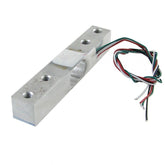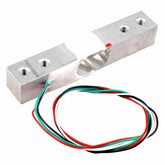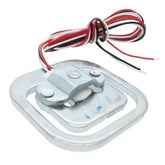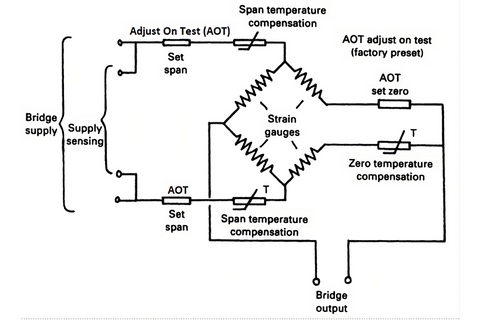Load cell : The Ultimate Guide
Summary
Welcome to our comprehensive guide on load cells, the critical components used in various industrial applications to measure force and weight. In this blog, we delve into the fundamentals of load cells, discussing their working principle and providing a clear understanding of their circuit diagram. We also explore the different sensor types utilized in load cells, shedding light on their unique characteristics and applications. By the end of this guide, you will have a solid grasp of load cells and their significance in the field of measurement and automation. So let's dive in and explore the fascinating world of load cells!
Introduction
A load cell is an essential component in the sphere of measurement, dimension and weighing systems. It's highly versatile in its nature. It plays a dominant role in accurately measuring the weight/force applied to it. These cells are comprehensively used in various industries for operations like, industrial weighing scales, and tension and compression testing. It is also used for material testing, force measurement in robotics etc. The list is long and hence it's an inexorable component in numerous diligences. The underlying and fundamental principle of a load cell is to convert the mechanical force into an electrical signal for dimension and analysis. They are designed in such a way that they can exhibit high sensitivity, reliability and durability. These features enable the cells to provide accurate, precise and harmonious measurements even in the toughest and grueling working environments.
As a result of technological advancements, load cells have evolved to incorporate various mechanisms for sensing such as strain gauges, and hydraulic and piezoelectric rudiments. This offers us a diverse range of choices that are suitable for our preferred working environments. Be it, commercial, industrial or scientific purposes, load cells have now become an indispensable tool which enables us to get precise weight and force measurements. They have a big hand in contributing to improved quality control, safety and effectiveness in multitudinous fields.
Working principle
The main principle of the load cell as mentioned above is to convert the mechanical force or weight into an electrical signal which is latterly used for measurement and analysis requirements.
These cells make use of different sensing mechanisms, out of which the most common and extensively used is the strain gauge-based load cell. This load cell contains a metal structure, usually in the form of a beam or a disc, which deforms when a force or weight is applied to it. The distortion causes a change in the electrical resistance of the strain gauge(s) attached to the metal structure.
The strain gauge is a thin metallic wire or foil that is bonded to the surface of the load cell structure. The materials used for making strain gauges have high sensitivity. Materials like constantan or nickel-chromium alloy are mainly used. When a force is applied to the load cell, the metal structure deforms which causes the strain gauge to compress or stretch itself. This deformation changes the length and cross-sectional area of the strain gauge and this leads to a change in its electrical resistance.
The strain gauge's resistance changes in direct proportion to the applied force or weight. This resistance change is measured using the Wheatstone bridge circuit. This circuit consists of four resistive elements with the strain gauge forming one of the legs of the bridge. The other legs of the bridge consist of precision resistors with known values.
The change in the resistance causes an imbalance in the Wheatstone bridge circuit. This imbalance results in a small electrical output signal known as the bridge output voltage. The magnitude of this voltage is directly proportional to the applied force or weight and can be measured using various instrumentation.
To measure and interpret the output signal from the load cell, the bridge output voltage needs to be amplified and processed. This is mainly done using a signal conditioning circuit or a load cell amplifier. The amplifier is used to increase the sensitivity of the load cell's output signal and converts it into a suitable form for further processing or display.
After getting the amplified signal, it is digitized and analyzed using data acquisition systems, microcontrollers, or computer interfaces. The digital representation of the load cell's output allows us to make precise measurements and it also enables additional calculations or control functions based on the measured force or weight.
It's necessary to note the fact that load cells require proper installation and calibration to ensure accurate measurements. High expertise is required to handle the installation and calibration part of the load cell, failing to which might lead to huge losses in the company/industry. Factors such as temperature, environmental conditions, and mounting techniques can affect the performance of load cells. Therefore, calibration and regular maintenance are to be maintained regularly for the best accuracy and reliability.

Circuit Diagram
Load cell sensor
The primary operating concept of this sensor stays the same as described in the blog's previous part. A load cell sensor is a transducer that detects force in a number of applications.
A load cell is a physical component or device that directly monitors the force or weight applied to it. It is often made up of a metallic structure to which strain gauges or other sensors are attached. Mechanical force is converted into an electrical signal by a load cell.
A load cell sensor, on the other hand, is a complete system that includes the load cell as well as signal conditioning circuits, amplifiers, and output interfaces. The sensor for load cells includes the whole setup necessary to measure and analyse the load cell's electrical output.
Since they relate to the same device and function, the terms "load cell" and "load cell sensor" are frequently used interchangeably.
Types of load cell
There are several types of load cells available, each designed to suit specific applications and requirements. The main types of load cells include:
1. Strain Gauge Load Cells:
They are the most commonly used load cells and they are based on the strain-gauge deformation principle.
2. Hydraulic Load Cells:
Hydraulic load cells utilize a fluid-filled chamber and a piston to measure force. This force changes the fluid pressure which is then converted into an electrical signal.
3. Pneumatic Load Cells:
They operate on the principle of air pressure changes. They consist of an air chamber that expands or contracts in response to applied force, changing the pressure within the chamber. This change in pressure causes an electrical signal which is later used for different measurement purposes.
4. Capacitive Load Cells:
They work on the principle of changes in capacitance to measure force. They are formed by two parallel plates separated by a gap. When a force is applied to it, the distance between the plates alters, causing a change in capacitance, which is then measured.
5. Piezoelectric Load Cells:
These cells utilize piezoelectric crystals that generate an electrical charge when any force is applied to them. The applied force deforms the crystals, creating a charge imbalance which is used for conversion into an electrical signal
6. S-Beam Load Cells:
As the name indicates, these cells have an "S" shape and are commonly used for tension and compression force measurements.
7. Beam Load Cells:
They are designed as a cantilever beam structure and can endure both tension and compression forces. They are widely used in industrial weighing scales and material testing applications.
Conclusion
Finally, load cells are critical components in the field of force and weight measurement, providing precise and dependable data for a broad range of applications. There is an appropriate solution for every unique purpose among the different varieties available, which include strain gauge, hydraulic, pneumatic, capacitive, piezoelectric, S-beam, and beam load cells. In a range of industries, including manufacturing, transportation, and aerospace, the load cells are responsible for accurate monitoring and management. They help to increase quality control, safety, and efficiency in a variety of operations. Accurate force and weight measurements may be obtained by selecting the suitable load cell type and ensuring correct installation and calibration, hence improving overall performance and productivity.
If you appreciate our work don't forget to share this post and leave your opinion in the comment box.
Please do check out other blog posts about Popular electronics
Make sure you check out our wide range of products and collections (we offer some exciting deals!)













